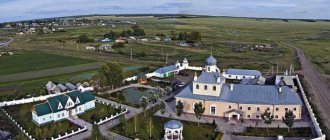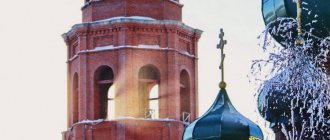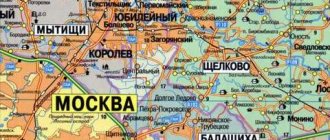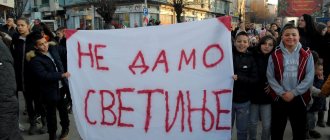| Kurgan Alexander Nevsky Cathedral |
Kurgan and Belozersk diocese of
the Kurgan Metropolis of the Russian Orthodox Church
- Diocesan administration: Russia, 640000, Kurgan, st. Volodarsky, 42
- Tel/fax
- Official site:
- Canonical territory: GO Kurgan, Belozersky, Vargashinsky, Ketovsky, Lebyazhyevsky, Makushinsky district, Mokrousovsky, Petukhovsky, Polovinsky, Pritobolny, Chastoozersky districts of the Kurgan region.
- Cathedrals: Epiphany and Alexander Nevsky in Kurgan
- On the map: Yandex.Map, Google map
No later than 1924 it became the Tobolsk Vicariate.
The independent Kurgan diocese was formed by a decision of the Holy Synod of the Russian Orthodox Church on February 22-23 [1] 1993, having been separated from the Ekaterinburg diocese within the Kurgan region.
On May 5, 2015, the independent Shadrinsk diocese was separated from the diocese, after which the Kurgan city district, as well as the Belozersky, Vargashinsky, Ketovsky, Lebyazhyevsky, Makushinsky districts, Mokrousovsky, Petukhovsky, Polovinsky, Pritobolny, Chastoozersky districts of the Kurgan region remained under the jurisdiction of the Kurgan department. At the same time, the Kurgan diocese was determined to be the center of the newly established Kurgan Metropolis [2].
Historical names
- Kurganskaya (vicariate, listed 1924 - listed 1950)
- Kurganskaya and Shadrinskaya (February 22-23, 1993 - May 5, 2015)
- Kurganskaya and Belozerskaya (since May 5, 2015)
Statistics
- OK. 2004 - 74 parishes, 84 clergy (74 priests; 10 deacons), 40 Sunday schools [3]
- December 2011 - 100 parishes (26 of them without registration of a legal entity), 91 clergy (78 priests; 13 deacons), 21 monastics (8 monks; 9 monks; 4 schema nuns) [4]
- December 26, 2014 - 103 parishes (26 of them without registration of a legal entity); 4 monasteries; 1 bishop's courtyard; 85 priests and 16 deacons, robed monks - 22 (including those serving in the parishes of the diocese), robed monks - 8, robed nuns - 14 (including 4 schema-nuns), robed nuns - 29 people [5]
Archpastors
Kurgan Vicariate of the Tobolsk Diocese
- Seraphim (Korovin) (1924) v/u, ep. Yalutorovsky
- Tobiah (Ostroumov) (1950) v/u, ep. Sverdlovsky
Kurgan diocese
- Mikhail (Raskovalov) (April 3, 1993 - August 11, 2008)
- Theophylact (Kuryanov) (August 11 - October 6, 2008) v/u, ep. Magnitogorsk
Story
One of the youngest dioceses of the Russian Orthodox Church, Kurgan, was created on February 23, 1993. It is located within the administrative boundaries of the region of the same name with the bishop's see in the regional center - the city of Kurgan.
Epiphany Church in Kurgan
The spread of the Orthodox faith in the Urals was slow, since the settlement of people in the harsh lands was difficult. Only with the beginning of Ermak’s activity did the construction of chapels and temples begin here, and after the implementation of the plan for the development of Siberia, first by the imperial family, and then by the Bolsheviks, the number of parishes here increased sharply.
However, the Kurgan region and the churches on its territory have always been classified as neighboring dioceses, and only in the period 1924–1931 a vicariate was founded here, which covered the Tobolsk and Siberian dioceses.
After 1932, the activity of the vicar department was discontinued and the parishes in this territory became subordinate to a neighboring bishop. The revival of the diocese occurred only with the end of the existence of the Soviet Union - in 1993, the Russian Orthodox Church decided to allocate an independent bishopric to the Kurgan region, since the number of parishes on its territory had increased sharply over the 3 years of freedom of religion.
Important! On February 23, the Holy Synod decided to create a diocese with its center in the city of Kurgan. Bishop Mikhail (Raskovalov), who stood at the head of this unit, received the title of Kurgan and Shadrinsk.
Geography of deaneries
- Central - Kurgan
- Eastern (Makushinsky, Petukhovsky, Chastoozersky districts)
- Makushino, village Bolshoye Kamenny, Petukhovo, village. Chastoozerye
- With. Belozerskoye, village Ketovo, Menderskoe village, village. Pershino
- p. Vargashi, s. Eloshnoye, village Lebyazhye, village. Lissier, s. Shoulder blades, p. Mokrousovo
Current state
After 15 years of ruling the diocese, Archbishop Mikhail died at the age of 56 and in his place the Holy Synod temporarily appointed vicar of the Chelyabinsk region Theophylact (Bishop of Magnitogorsk). He took over the reins of the deanery temporarily, until in October 2008 the Synod elected a new archbishop - Konstantin (Goryanov), rector of the Theological Academy of the city of St. Petersburg and vicar of the diocese of the same name.
The deaneries in the region grew gradually and already in 2015, by the decision of the Synod of the Russian Orthodox Church, the Shadrinsk diocese received independent status, and the bishop of Kurgan became Belozersky, while the bishop himself was changed - Joseph (Balabanov) took the department.
Metropolitan Joseph of Kurgan and Belozersk
These transformations allowed the Synod to create an independent new metropolis of Kurgan, which included new administrative units. Over the past 10 years, the diocese has grown significantly, as evidenced by statistics:
- In 2004, only 74 parishes were registered, where 74 priests and 10 deacons worked. Half of the churches had a Sunday school.
- In 2011, 100 parishes were already registered, the number of clergy increased to 91 people. During this period, the first monastery was opened, so the monastics were also registered - their total number was 41 people.
- In 2014, there were 103 parishes, 4 monasteries, a total of 101 people and 80 monks were registered as serving in churches.
The steady growth of parishioners in the churches of the diocese allows its departments to carry out social and educational work among the local population.
Temple of St. Seraphim of Sarov in Kurgan
The clergy observe not only the growth of parishioners, but also their desire to become churchgoers, a true part of the Universal Church. Social work allows us to draw attention to the Orthodox faith and serves as an excellent evangelistic tool.
Activity
The main city of the diocese is Kurgan - the administrative center, the archbishop's chair, the cathedral are located here, and departments for working with the population are concentrated. There are five deaneries in total:
- Central in the city of Kurgan;
- Eastern, covering the Petukhovsky and Makushinsky districts;
- Western, extending to the Ketovsky and Belozersky districts;
- Northern in Lebyazhyevsky and Vargashinsky districts;
- Yuzhnoe in Polovinsky and Pritobolny districts.
Separate parishes are located in monasteries, of which there were initially four, but after the separation of the Shadrinsk See, only the Chimeevsky Kazan Monastery and the Holy Spiritual Women's Monastic Community remained under the subordination of the Kurgan Bishop.
Holy Kazan Chimeevsky Monastery
Social and educational work is carried out by diocesan departments, including:
- missionary;
- education and catechesis;
- on working with youth;
- charitable.
Through their efforts, temperance societies, a community of teachers and doctors, as well as an official sisterhood ministry that works in local medical institutions were organized.
Spiritual education in the region can be obtained at the Orthodox school named after Prince Alexander Nevsky. And in secondary school No. 29, an experimental Orthodox class has recently been operating. Previously, there was a religious school in the regional center, but it has recently been closed.
Important! Much attention is paid to the media; there is a newspaper in the region called “Orthodoxy”, which is published every month. The city council insisted, and spiritual sections with answers from priests and their short notes are published in secular publications.
They can be found in the publications “Dalmatovsky Vestnik” and “Rural Nov”. There is a video channel on YouTube, where services from churches, short news clips are published, and the life of parishes and the diocese as a whole is sanctified. Detailed information about the work of the departments can be found on the official website of the diocese.
KURGAN METROPOLIA
The spread of Christianity in modern territory. K. m. began in the process of annexing Siberia to Russia (the campaign of Ermak Timofeevich in 1581-1585). The settlement of the region was accompanied by the construction of chapels, churches and mon-rays. Dalmatovsky was one of the first to be founded on the territory of the Trans-Urals in honor of the Dormition of the Holy One. Mother of God Monastery (1644) and Verkhnetechensky Monastery in honor of the Entry into the Temple of the Most Holy. Mother of God convent (1680). Afterwards The churches of Saints Florus and Laurus were also built in the Beloyarsk fortress (1711), Kirillovskaya in the village. Kislyansky, Chelyabinsk district. (1721), as well as in the villages of Cheremukhovsky and Ust-Suerskoye, Kurgan district. (1733). During the same period, Russian Pioneers founded the settlement of Tsarevo Gorodishche near Tsarev Kurgan (1679; from 1738 Kurganskaya Sloboda, from 1782 Kurgan).
Vvedensky Monastery in the village. V. Techa. 1743 Photograph. 10s XXI century Vvedensky Monastery in the village. V. Techa. 1743 Photograph. 10s XXI century
Territory bud. K. m. was part of the dioceses: Tobolsk (see Tobolsk and Tyumen diocese), Orenburg (see Orenburg Metropolis, Orenburg and Saraktash diocese) and Perm (see Perm Metropolis, Perm and Kungur diocese). In 1851, Shadrinsky district. was annexed to the Ekaterinburg Victoria, transformed in 1885 into the Ekaterinburg and Irbit diocese (see Ekaterinburg and Verkhoturye diocese), which in 1923 included the entire territory of modern. K. m. In 1924-1934. There was a Kurgan vicariate of the Tobolsk and Siberian diocese.
In the XVII-XX centuries. on the territory of modern More than 200 orthodox buildings were built. churches, among them: Trinity Church, 5-throne Church of the Nativity of the Mother of God, church in the name of St. blgv. book Alexander Nevsky (1902) in Kurgan. In 1905, not far from the Alexander Nevskaya Church. the building of the Kurgan DU was built with a house church in honor of St. ap. John the Theologian. The premises of the house Panteleimon Church, consecrated at the city hospital on March 5, 1884, have also been preserved.
Church in honor of the Kazan Icon of the Mother of God in the Kazan Chimeevsky Monastery in the village. Chimeevo. Photo. 10s XXI century
Church in honor of the Kazan Icon of the Mother of God in the Kazan Chimeevsky Monastery in the village. Chimeevo. Photo. 10s XXI century
In the 20-30s. XX century all the temples were closed and were in disrepair. Divine services were resumed only in 1942 (April 2, 1942 in the Peter and Paul Church of Kurtamysh). During the Great Patriotic War on the territory of modern. K. m. there were 2 active Orthodox churches. temple, in 1946 their number increased to 7, by 1956 - to 14.
Since 1944, the believers of Kurgan have unsuccessfully sought the opening of a church in the region. center of the Trinity Cathedral, in 1957 the cathedral was blown up. Only 30 Oct. In 1956, the Holy Spiritual Church was opened. in the village Ryabkovo (now Kurgan district). On major holidays, up to 800 people visited the temple. In 1963, under the pretext of reconstruction of the village, the church was demolished, and the community was asked to settle in a new place, in the village. Smolino, where the baptismal room with an area of 68 square meters was transported. m, which became a house of worship after the addition of the altar.
As of 1 Jan. 1962 on the territory of the Kurgan region. there were 12 active Orthodox churches. churches, in which 16 priests, 3 deacons, and 5 psalm-readers served. The church membership of the parishes numbered 283 people. From 1962 to 1964, at the height of anti-church repressions, the number of operating churches was reduced to 10 and until the end. 80s practically did not change. By 1990, the number of temples had doubled.
Aug 25 1989 The Kurgan Regional Executive Committee decided to transfer the building of the Church of St. to the Russian Orthodox Church. blgv. book Alexander Nevsky, in which the region was located. local history museum. The first prayer service in the newly opened church took place on December 5. 1991
By decision of the Patriarch of Moscow and All Rus' Alexy II and the Synod of February 22-23. In 1993, the independent Kurgan and Shadrinsk diocese was separated from the Ekaterinburg diocese. 3 Apr. In 1993, in the Epiphany Patriarchal Cathedral in Moscow, the consecration of Archimandrite was performed. Mikhail (Raskovalov) as Bishop of Kurgan and Shadrinsk.
Church in honor of the icon of the Mother of God “Joy of All Who Sorrow” at the Dalmatovsky Assumption Monastery. Photo. 2015
Church in honor of the icon of the Mother of God “Joy of All Who Sorrow” at the Dalmatovsky Assumption Monastery. Photo. 2015 The newly formed Kurgan and Shadrinsk diocese had 37 parishes and was divided into 3 deaneries: Shadrinsk, Kurtamysh and Kurgan. In 2003, there were already 65 parishes, 4 monasteries operating in the diocese, and over 80 clergy serving.
During the years of management of the diocese, Bishop. Mikhail revived the Dalmatovsky husband. mon-ry and Verkhnetechensky women. monastery, and also 2 new monasteries were established: women’s. Monastery of Praise of the Mother of God in the village. Borovsky Katai district (2000) and Kazan Chimeevsky husband. mon-ry (2002). Aug 6 In 1994, the discovery of the relics of St. Dalmat of Isetsky (see Dalmat (Mokrinsky)), glorified among the Siberian locally revered saints on July 17, 2004. Among the new martyrs and confessors of Russia, the schmch was canonized. Arkady Garyaev, priest of the St. Nicholas Church. Borovsky, tortured by the Red Army in 1918, whose relics were found on June 10, 2007. In 2004, according to the determination of the Synodal Commission for the Canonization of Saints, the list of the Kazan Icon of the Mother of God, called “Chimeevsky,” was included in the calendar month for general church veneration.
14 Sep. 2006 Orthodox church opened. secondary school named after. St. Alexander Nevsky. Its founder is the St. blgv. book Alexander Nevsky. In 2007, the summer Orthodox church began for the first time. Children's Health Camp. In K. m. is valid for approx. 50 Sunday schools with approx. 1 thousand people Almost all Sunday schools have parish libraries.
In 2007, the 1st issue of the monthly diocesan organ “Orthodox Newspaper - Kurgan” was published, which covers events in the life of the Russian Orthodox Church and modern times. K. m. From Dec. 2009 Railway began publishing in Kurgan. "Russian field of Trans-Urals".
Aug 11 2008, after the death of Bishop. Michael, by decree of Patriarch Alexy II, bishop was appointed temporary administrator of the Kurgan and Shadrinsk diocese. Magnitogorsk Theophylact (Kuryanov), vicar of the Chelyabinsk and Zlatoust diocese.
Oct 6 In 2008, Archbishop was appointed administrator of the Kurgan and Shadrinsk diocese. Tikhvinsky Konstantin (Goryanov). On the initiative of the archbishop. Constantine in the diocese began to host the Orthodox exhibition-fair “The Good Light of Christmas”, the Easter Festival of choir choirs and ensembles, general diocesan confession, Orthodox Days. books, etc. In 2009, a particle of the relics of St. Alexander Nevsky from the Alexander Nevsky Lavra in honor of the Holy Trinity. On the day of memory of St. blessed prince (September 12), church and secular celebrations “Alexander Days” began to be held, in which military personnel, cadets and cadets, patriotic organizations, and regional leaders took part. 12 St. Scholarships were established. Alexander Nevsky for youth. In 2012, particles of the relics of the blessed princes were brought. and kng. Peter (David) Georgievich and Fevronia (Euphrosyne), which are located in the chapel of Saints Peter and Fevronia of the Epiphany Church in Kurgan.
4 Feb In 2013, at the Council of Bishops of the Russian Orthodox Church, a church-wide glorification of St. Dalmata of Isetsky. Earlier, in 2012, a diocesan medal was established in the name of this saint.
In 2010, a baptismal church with a baptistery in the name of St. equal to book Vladimir (Vasily) Svyatoslavich in the crypt of the Cathedral in Kurgan. For 2012-2013 3 churches were built and consecrated in the city: a stone church in honor of the Port Arthur Icon of the Mother of God “Triumph of the Most Holy. Mother of God" (the first stone church in Kurgan in the last 110 years), stone in the name of St. healer Panteleimon and a wooden one in the name of St. Seraphim of Sarov. 5 Jan 2012 Archbishop. Constantine consecrated a large stone church in honor of the Nativity of Christ in the village. Chastoozerye. On the territory of the Alexander Nevsky Cathedral, for the 20th anniversary of the formation of the Kurgan and Shadrinsk diocese, a new 2-story EU building was built. In con. In 2014, the construction of the 4-altar Epiphany Cathedral in Kurgan was completed, and a diocesan residence was built.
On May 5, 2015, by resolution of the Synod of the Russian Orthodox Church, the K. m. was created; The Kurgan and Shadrinsk diocese is divided into the Kurgan and Belozersk diocese and the Shadrinsk and Dalmatov diocese within the K. m. Archbishop. Joseph (Balabanov) of Birobidzhan and Kuldur was appointed manager of the Kurgan and Belozersk diocese, and the head of the K. m. Bishop of Shadrinsk and Dalmatov, elected the clergy of the Volgodonsk diocese, Archpriest. Vasily Mashtanov (in monastic life Vladimir; from May 10, 2015 - archimandrite; July 11, 2015 ordained bishop). May 24, 2015 Archbishop. Joseph was elevated to the rank of metropolitan by the Patriarch of Moscow and All Rus' Kirill (Gundyaev).







